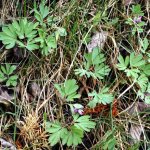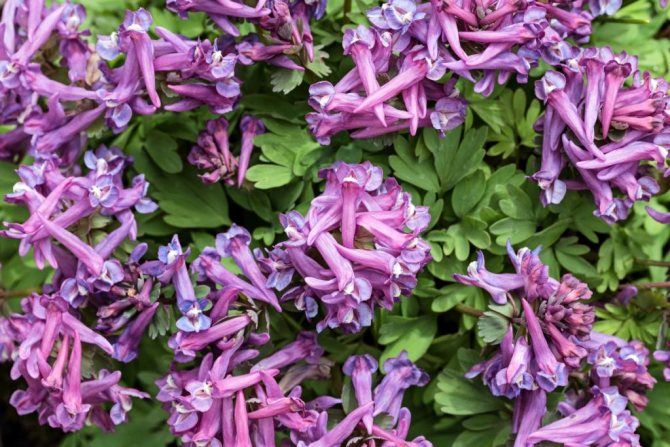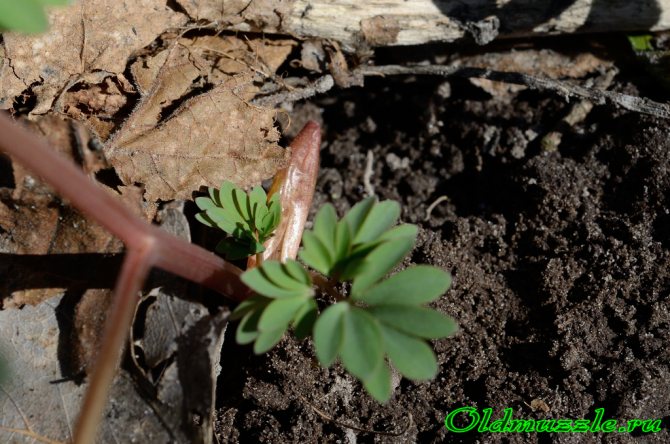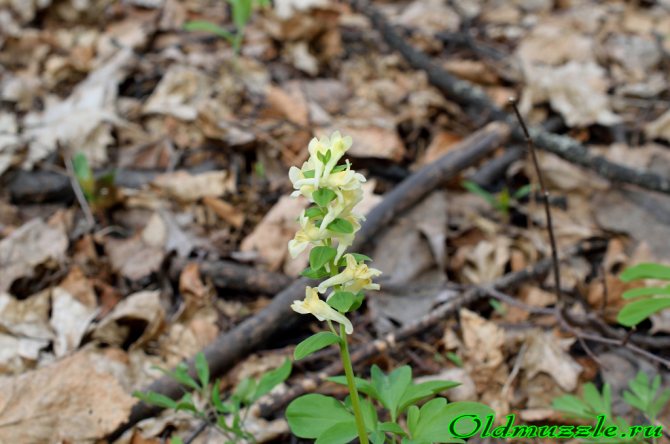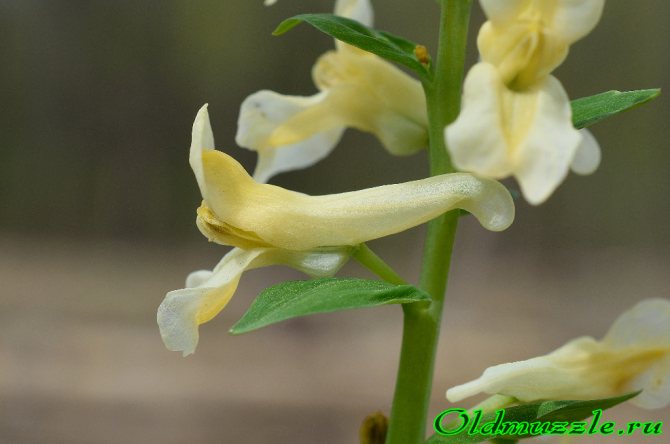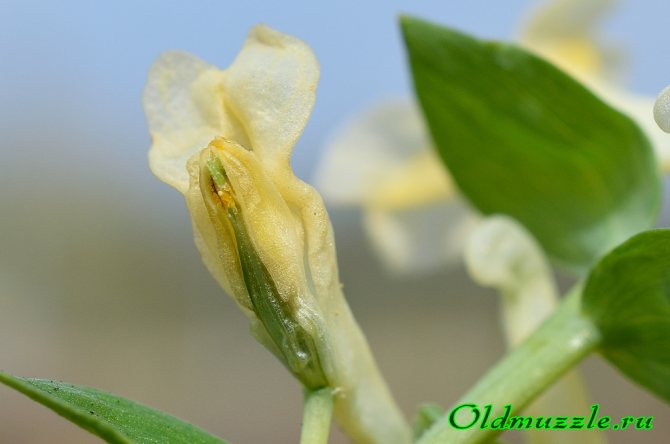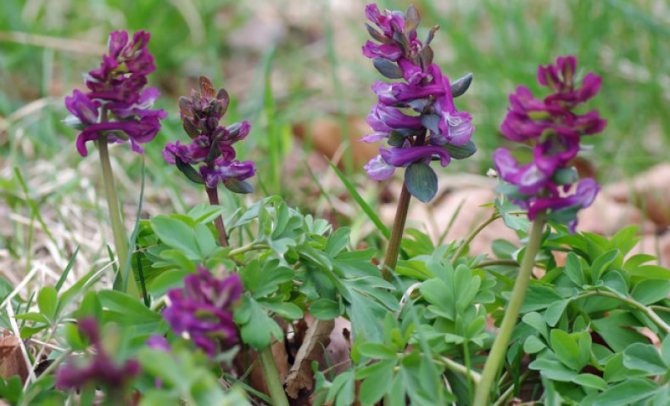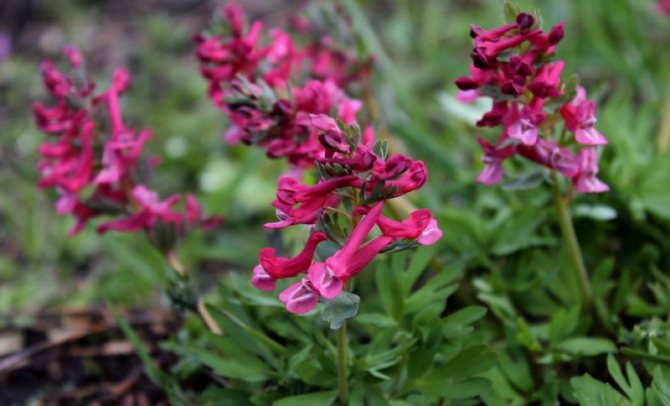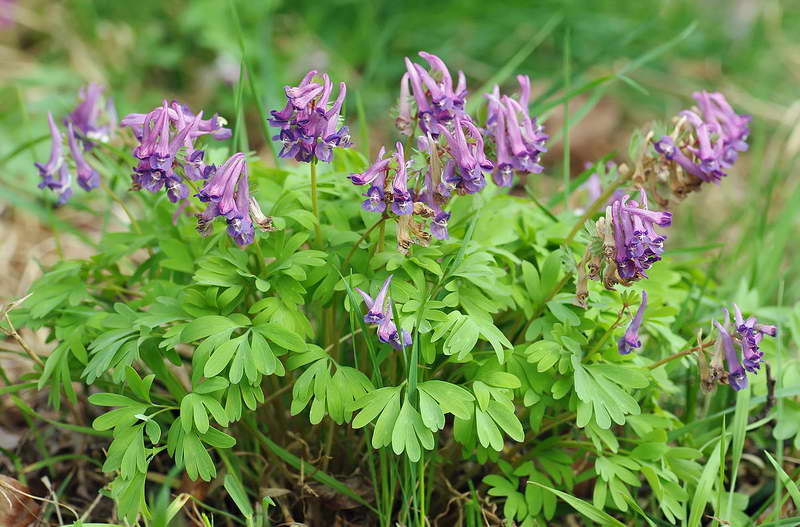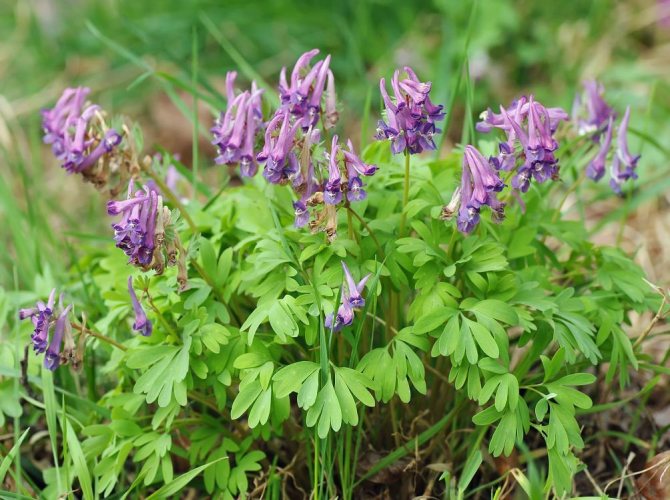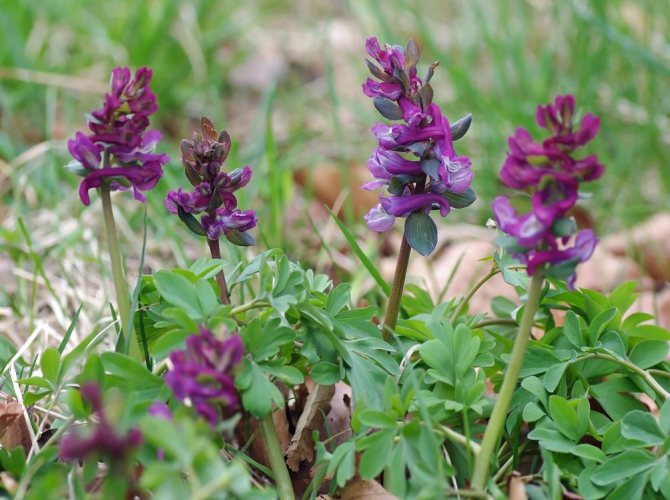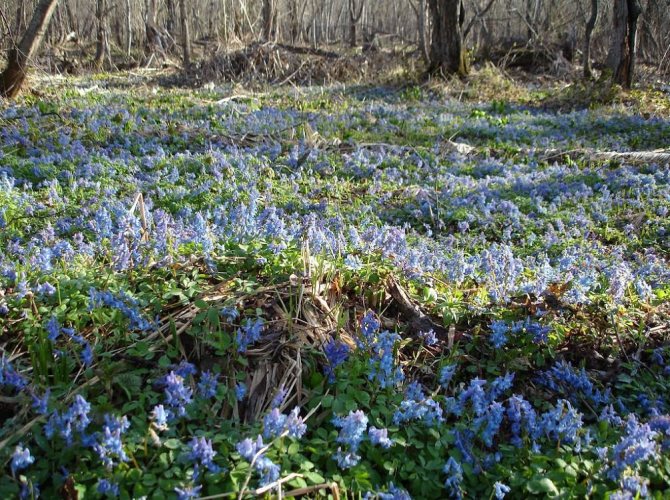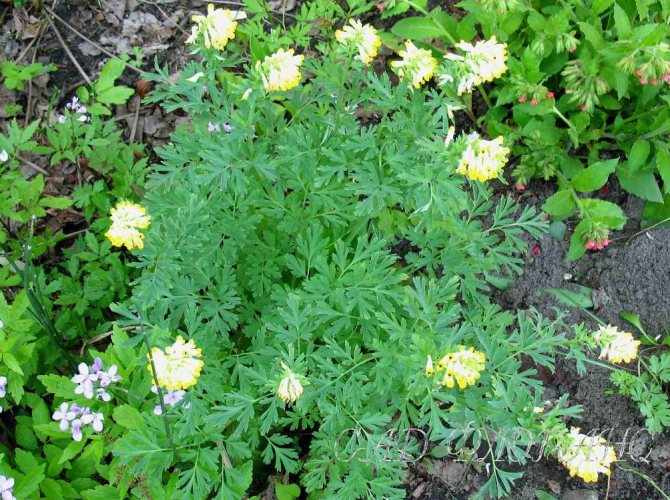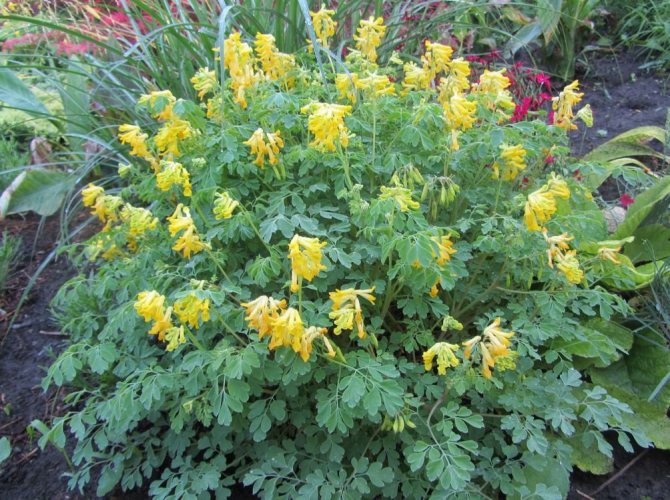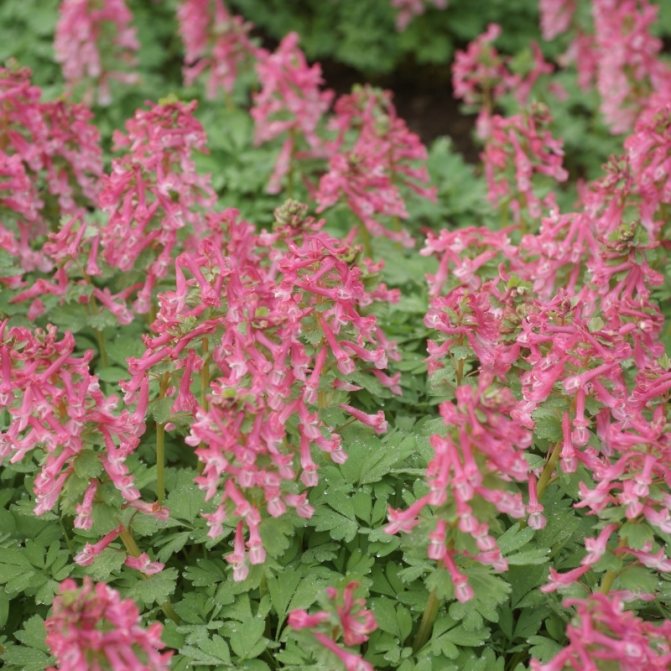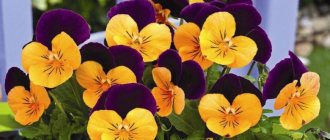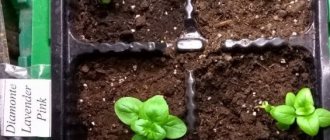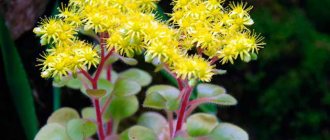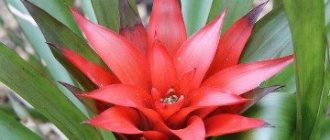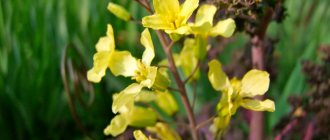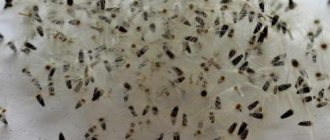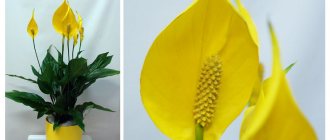Corydalis (Corydalis) is a perennial herb belonging to the Dymyankovye family. It is an ephemeroid - it has a short growing season. Germinates quickly, blooms, gives fruit, and then the aerial part dies off completely. It appears in the forest in April, and by the end of May or beginning of June you will not find traces of the corydalis.
About 200 species of Corydalis are common in China, the Himalayas, they can be found in the temperate latitudes of the entire Northern Hemisphere. There are 3 varieties growing in our forests: the corydalis hollow, dense and Marshall.
Botanical description
The root system is tuberous. Every year, a new one is formed inside the old rounded nodule, and that becomes its shell. The fleshy stem is 15-25 cm long. The stem is densely leafy. Leaves are cut twice or thrice, painted in bright green color, may have a bluish tint. Loose racemose inflorescences appear on the tops of the shoots - they rise like candles. Each individual flower is elongated from the base, ending in 4 small petals, the tips of the petals are slightly curved outward. The color can be yellow, pink, blue, purple, white.
Corydalis is the official name of the plant, given by the name of the crested lark, precisely because of the shape of the flowers that resemble a bird's crest.
The fruit is an oblong capsule resembling a pod. The seeds are large, black-colored. Forest ants eat the succulent seed plant, collect seeds, thereby spreading the corydalis.
Corydalis is an excellent honey plant. It can only be pollinated by insects with long proboscis (bumblebees, for example). Due to its spectacular decorative appearance, it has become popular in gardening.
Corydalis hollow is used in folk medicine due to the presence of alkaloids. The decoction and extract are used as an analgesic, anti-inflammatory, hemostatic agent.
Description
Corydalis is a flower that does not need special care. China is considered its homeland, or rather the western and central territories of the Celestial Empire. The plant grows in the temperate latitudes of the Northern Hemisphere. Corydalis lives mainly in deciduous forests, in large families. You can often see a living colorful carpet of these flowers in the wild forest.
To date, more than 300 species of Corydalis are known. Its other name is ryast.
What does a crested flower look like? This is a low, no more than 30 cm herbaceous plant. Most often it is perennial, although annuals are also found. Belongs to the Dymyankov subfamily, the Makov family. The Latin name is Corydalis (coridalis).
The duckweed has lacy leaves that resemble fern foliage. Below you can see the corydalis flower in the photo - four-petal, with an elongated upper part.

The length of the flower is about 4 cm. The buds are collected in racemose inflorescences. The color of the inside of the bud (throat) and the outside of the petals are different. Near each flower there is a small leaf - a bract.
After a short flowering, the Corydalis has seeds in the form of a pod-shaped capsule. The plant often reproduces by self-seeding.
How does the crested (flower) reproduce?
Describing breeding methods will help you grow wonderful flowers in your flower bed. If you want to have crested crestedlings in your garden, you can simply transplant a plant from the forest, the main thing is to leave a large lump of earth.When digging up a flower, do not forget that its roots are quite deep. Corydalis can also reproduce with seeds.
In culture, plants run wild, spreading over long distances from the planting site. Quite often, ants carry seeds to a wide variety of places. Corydalis are usually found in the shade of trees, where the ground is covered with fallen leaves. Since flowering starts very early, they do not interfere with the growth of other crops in any way.
In nature, the Corydalis chooses places in the forest with humus soil, and in culture it takes root in the usual one. Excessive moisture, bright lighting and sodiness of the ground are detrimental for her.
Forest varieties
Gardeners love to grow unpretentious flowers. Below you can see a photo of the Corydalis.
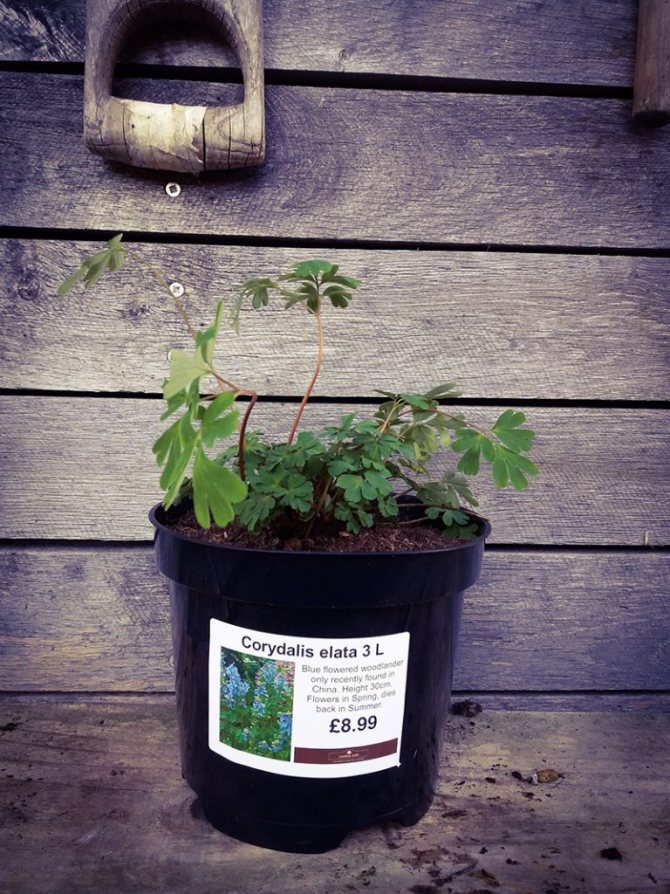

The description of this plant should start with the following qualities:
- frost resistance;
- no need for specialized care;
- good melliferous properties;
- attractive appearance;
- simple reproduction.
But even taking these qualities into account, it is necessary to know what conditions the corydalis loves in order for the plant to be strong and healthy.
There are quite a few species of domesticated and forest species of coridalis. Below you can see the corydalis flower in the photo.
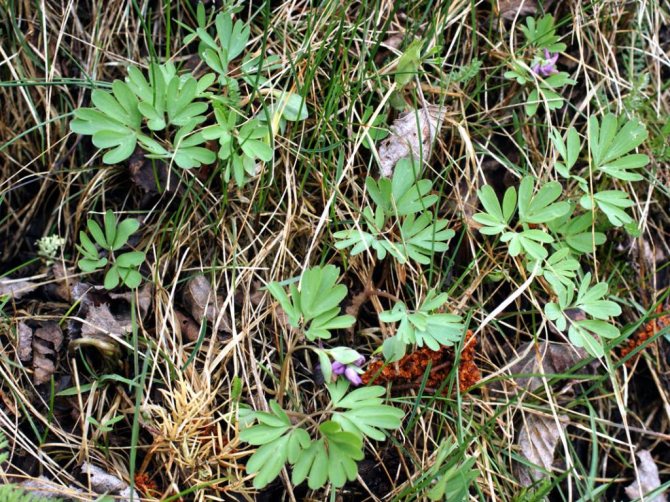

The description of all varieties can be reduced to just a few categories. Plants are divided into annual and perennial, rhizome and tuberous. According to their habitat, they are divided into forest, tundra and alpine ones. A separate group is made up of hybrid varieties bred by breeders.
Forest varieties of coridalis are ephemeroids, that is, plants with a very short growing season. Corydalis appears in April. In a couple of months, she manages to grow, reach maturity, quickly bloom and shed seeds. Then the ground part dies off, and a developed root system with thick rhizomes or tubers remains in the soil.
The most common forest varieties:
- Haller's corridal. Low, up to 25 cm plant with pinkish or pale purple buds and green bracts. It can be found in deciduous forests in Europe and in our country.
- George Baker. With beautiful red flowers, which are often cross-pollinated with other species of corydalis, due to which the buds become of a different color.
- Beth Evans. With pink inflorescences.
- Koridalis Blue Topaz. The buds are of an unusually beautiful deep blue color.
- Hollow Corydalis. She is tuberous. Prefers shady growth areas. Because of this, it grows slightly taller than its counterparts, up to 35 cm.The flowers are pinkish-purple, rarely white. The bract is purple.
- Kashmir Koridalis Belongs to the group of alpine ones. With pale blue flowers.
- Crested Marshall. It looks like a tuberous, with soft cream flowers.
- Corydalis Ledebour. Tall plant with several leaves near the ground. Inflorescence cluster - multi-flowered. The color of the flowers is from yellow to pink.
- Corydalis yellow. One of the few representatives of this species with a long flowering - from early summer to September. It can be easily adapted for growing in your garden, you just need to find a slightly shaded area with suitable soil. The plant will multiply by self-seeding.
- The corridalis is sulfur-yellow. Slightly lower than the yellow corydalis, and the color of the flowers is different - yellow-cream.
- Corydalis noble. Tall, up to 60 cm, plant. The flowers are pale yellow with orange edging around the edge.
The last three varieties are rhizomatous. They, unlike everyone else, do not die off after flowering, so there will be no empty areas when grown in the garden.
Crested species with photos and names
The genus has about 320 species. They are divided into groups according to growing conditions (desert, Asian, etc.). Consider the species grown in the gardens of our latitudes.
Corydalis dense or Solida Corydalis solida
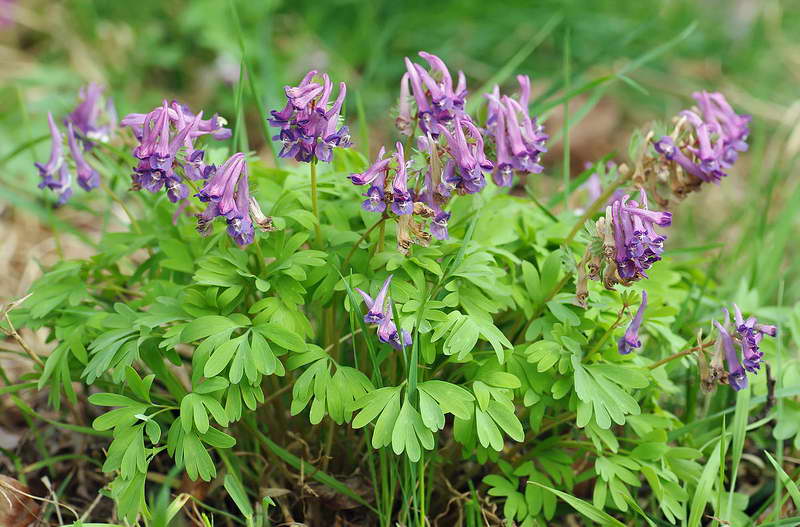

Corydalis dense or Hallera Corydalis solida photo
The natural habitat is sunny edges and light crowns of trees in the European part of Russia and Western Europe. The small tuber is 15 mm in diameter. The stem extends by 10-25 cm. 2 pinnately dissected leaves extend from the base of the stem. The dense, cylindrical inflorescence blooms in mid-April. The color of the flowers is pink-purple.
Corydalis hollow Corydalis cava


Corydalis hollow Corydalis cava photo
Prefers the edges of deciduous-coniferous and broad-leaved forests in Europe and Asia Minor. The height of the stem reaches 40 cm. The leaf plates are triangular in shape and consist of pinnately dissected leaves. The flowers are dark purple in color.
Corydalis Marshall Corydalis marschalliana


Corydalis Marshall Corydalis marschalliana photo
Distributed in the South-Eastern part of Europe. Stems 15-30 cm high are reddish-green in color. The leaves are tripartite, colored green with a bluish tint. At the end of April, a 25 cm long peduncle appears. The flowers have a delicate creamy yellow color.
Corydalis dubious Corydalis yanhusuo


Corydalis dubious or Yanhusuo Corydalis yanhusuo photo
Distributed in the forests of Kamchatka, Sakhalin, the Kuril Islands. The stem length is 10-15 cm, they are covered with a bluish bloom. The flowers are sky blue. Blooms in late April.
Corydalis noble Corydalis nobilis


Corydalis noble Corydalis nobilis photo
Herbaceous plant about 80 cm high. The leaves are pinnately dissected, painted bright green. Inflorescences bloom in early May. The yellow flowers are bordered with a purple stripe.
Corydalis yellow Corydalis lutea
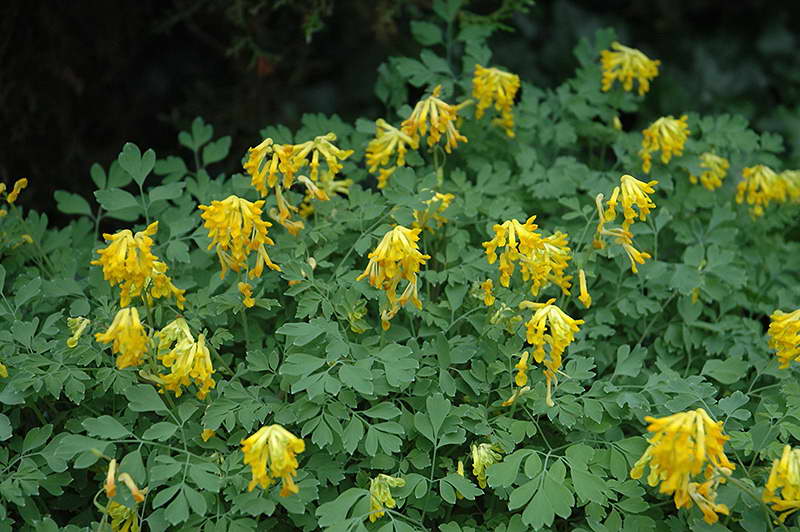

Corydalis yellow Corydalis lutea photo
The habitat is the western part of Europe. Has a creeping rhizome. The stem is 10-40 cm high. At the base of the stem are attached dissected leaves of a gray-green color. Flowers bloom immediately after the snow melts. They are sunny yellow in color.
Varieties popular with gardeners
Below in the photo are the flowers of the corydalis of an unusual color. They are pale yellow and small. And at first they seem inconspicuous and inconspicuous.
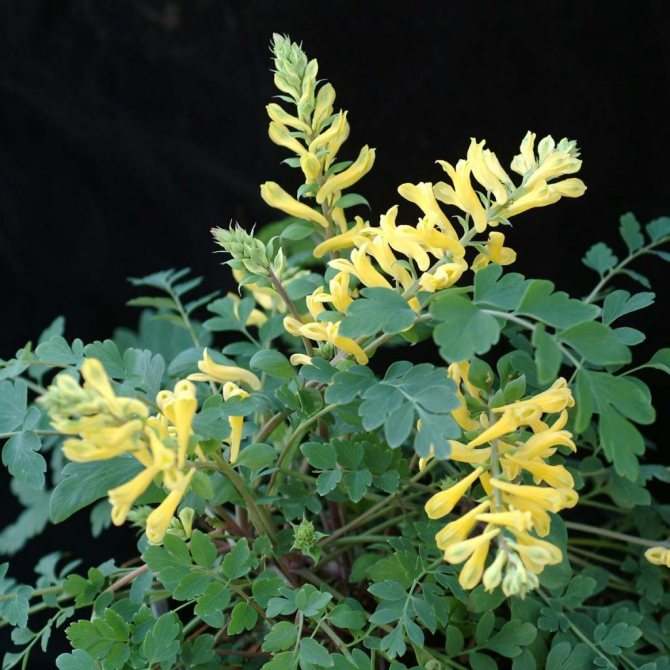

In fact, they grow in lush dense thickets, and you immediately pay attention to them. Despite all the variety of varieties, gardeners prefer to grow yellow, sulfur-yellow and noble crested beetles on their plots. They are the most unpretentious, frost-resistant, with a long flowering period. After the seeds ripen, the green ground part does not die off, so you don't have to guess how to fill the voids on the club or alpine slide.
Haller's corridalis (dense corydalis) is suitable for growing indoors.
Contraindications and side effects
Corydalis treatment should be prescribed only by a doctor. Indeed, in this case, errors in the preparation of the product and the choice of dosage can be irreparable. The alkaloids present in the grass have a very strong effect on the human body.
It is strictly forbidden to take the drug and pharmaceutical preparations based on it:
- pregnant women;
- women during lactation;
- children under 12 years old;
- patients with diabetes mellitus;
- people suffering from obesity;
- epileptics;
- asthmatics;
- having angina pectoris;
- people who have a tendency to diarrhea;
- patients with exacerbation of ulcers in the gastrointestinal tract.
Landing site and soil
How to properly grow a crested flower? Plant care should start with choosing the right place. This will provide 90% success.
Coridalis is best planted alongside other early flowers such as crocuses and tulips to create a beautiful arrangement. The ideal planting site depends on the type of plant. If the corydalis is forest, then it should be placed on a shady area or in partial shade. In this case, the soil should be sufficiently loose.Alpine varieties do well in open and well-lit areas with sandy loam soil. It is good to place such varieties on a hill.
All Corydalis species prefer neutral or slightly acidic soils.
Contraindications
- children;
- pregnant and lactating women;
- with stomach and intestinal ulcers, loose stools;
- with diabetes;
- with epilepsy;
- with asthma;
- with heart disease;
- with individual intolerance.
Attention! Corydalis is a very poisonous plant and therefore, for medicinal purposes, it should be used very carefully, after consulting a doctor or a knowledgeable herbalist. During treatment, the recommended dosage must be strictly observed! An overdose of drugs prepared on the basis of the corydalis leads to such side effects as: suppression of reflex activity and derivatives of movements, catalepsy. The alkaloids present in the corydalis have a narcotic effect on the human body, reminiscent of the effect of morphine. In case of corydalis poisoning, it is necessary to rinse the stomach with water with potassium permanganate, take activated charcoal and call an ambulance.
Watering mode
All flowers need the correct watering regime. In the photo there is a crested crested bird, strewn with morning dew. In most cases, this moisture and rain will be enough for it.
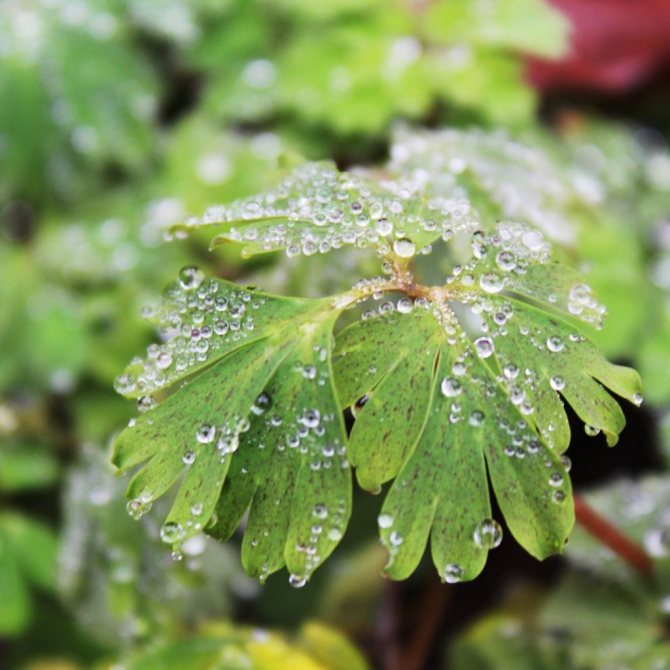

In addition, at the beginning of spring, when the snowdrifts have just disappeared, it is not necessary to water the plant, since the ground is quite wet. The rest of the time, watering is moderate, if necessary. Desert and alpine corridalis need to be watered less frequently as these plants are accustomed to dry soil and dry weather.
It is important to provide the bushes with good drainage. If the soil is not loose enough, then the roots of the corydalis will quickly rot.
Chemical composition
For medicinal purposes, the roots, stems, foliage and flower brushes of the herb are used. Found in them:
- alkaloids (bulbocapnine, cordiamine, coricavin, bikuculin, corybulbin, horse meat, corridalin);
- phytoncides;
- tannins;
- coumarin.
The chemical composition of the herb eloquently warns of unpredictable self-diagnosis and self-medication results. Indeed, according to experts, even a slight excess of the required dose can provoke convulsions and death.


For example, bulbocapnin present in the corydalis in small doses causes drowsiness, and in case of an overdose it paralyzes the central nervous system, lowers blood pressure and increases salivation.
The same goes for bicuculin, which is a seizure poison that blocks receptors. Coribulbin and coridamine help slow the heart rate.
Preparing for winter
In the photo, the corydalis flower looks very delicate. It seems that the plant may die from a slight temperature drop. In fact, coridalis is notable for its enviable frost resistance. When the aerial part of the plant dies off, its remains must be removed. A tuber or thick rhizome will remain underground, which will overwinter perfectly. The only exception is the Chinese corridalis. Its underground part may not survive frosts below -23 ° C.
In order not to forget the place where the corydalis grows, it must be marked somehow - with a stone or a peg. This will greatly facilitate the gardener's work next year.
Representative of the Dymyankov family
The corydalis plant belongs to the family of dicotyledonous plants, close to poppy plants. The genus has nearly four hundred species. Many of them grow in the temperate zone of the Northern Hemisphere. The name comes from the Greek word meaning "helmet" due to the shape of the flower.
In a perennial herbaceous plant, tuberous. Leaves are basal with a bluish bloom, strongly dissected. The racemose inflorescences rise slightly above the foliage.The flowers are small in size, yellow, pink and bluish-purple in color.
Corydalis, like snowdrop, tulip, forest forest, crocus, is an ephemeroid plant, since its growing season is short. These plants delight us with their flowering in early spring, when nature has not yet pampered with greenery. As soon as the seeds ripen, yellowing begins, and later the dying off of the aboveground part of the plant.


Reproduction
Corydalis is propagated by two methods - vegetative and with the help of seeds. The first way is the easiest. Coridalis can be propagated by tubers or by dividing the rhizome. Usually, this procedure is carried out every three years, at a time when the plant is dormant. However, you can do this in early spring. The tubers are planted one at a time. The rhizomes are divided so that at least one growth bud remains on each part. Planting material is placed in holes to a depth of 15 cm.The distance between them should be at least 10 cm.
This is how the corydalis seeds look in the photo.


These are dense dark peas that need to be picked at the moment when they have already become dark, and the box has remained green. If this moment is missed, the seeds will quickly fall to the ground, and insects will take them away.
Propagating corridalis by seeds is more difficult than vegetatively. They do it as follows:
- Collect seeds.
- Give them a few days to ripen. To do this, it is enough to keep them in a dry place.
- Deepen the planting material in the soil in a pot, moisten and wait for shoots. Any loose soil can be used.
- The soil must be moist at all times.
The sprouts will not appear immediately. They are transplanted into open ground for the next year. And the plant will bloom only after the onset of maturity, after 2-4 years.


Development features
Before breeding a crested beetle, you need to find out how the plant develops. After flowering (this happens approximately in April-May), the aerial parts quickly die off, and the ripe seeds fall to the ground. Tubers with accumulated nutrients remain in the soil. At this time, there is still practically no foliage on the trees and shrubs.
After flowering, the Corydalis, like other spring ephemeroids, disappear, reappearing the next year. So that the place where the flowers grew is not empty, you can plant various short-rhizome plants that bloom in summer or autumn: cropping flowers, lilies or irises. So your site will turn into a real conveyor of flowering plants. Also, for planting, you can choose a place under ornamental shrubs: lilac, rose or weigela.
Given in this article) looks great in combination with perennial plants, which much later begin to build up the aboveground mass. So, for example, crested beetles decorate a flower bed when phloxes or hosts are barely visible. By the fall, the plants will rise, closing their large leaves, and will hide the void thus formed after the death of the aerial part of the ephemeroids.
The low growth of the corydalis allows you to beautifully decorate and It is enough to find a place for them near a small bush that will shade the flower.
Forcing primrose
Below in the photo - crested flowers in a pot. They can be grown at home even in the off-season.
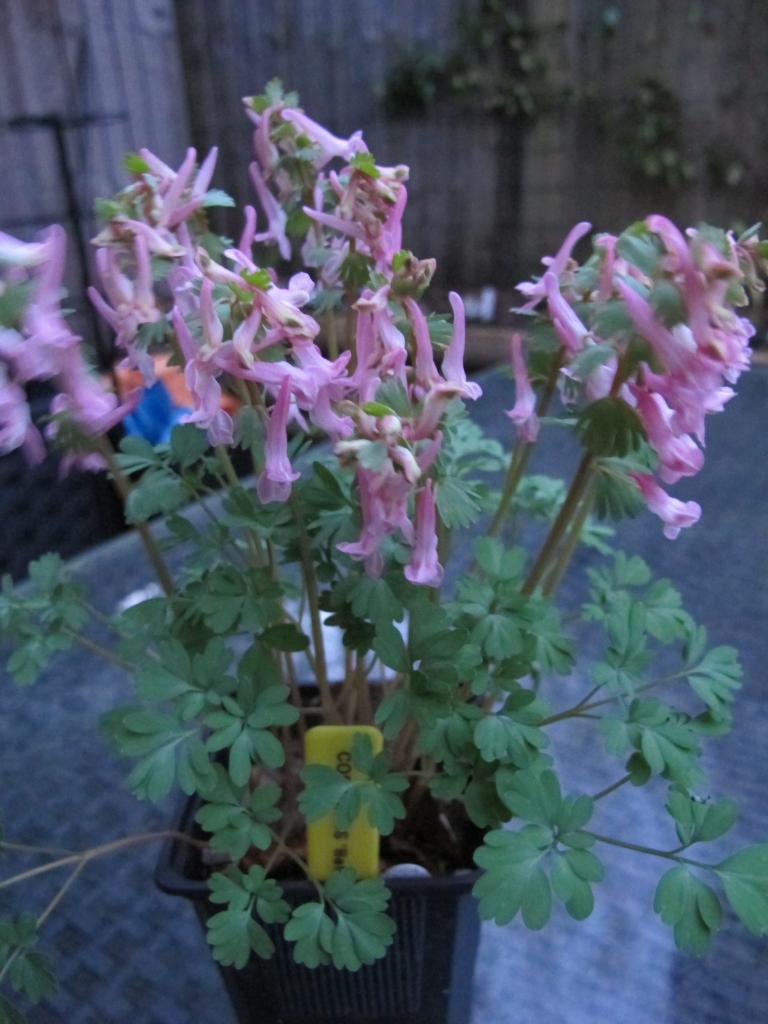

Although this is a rather laborious process. When forcing primrose in room conditions, only dense corydalis is used. In order for everything to go well, you need to follow a few simple tips:
- Use tubers only healthy, large, with a uniform density, without signs of rot.
- Planting material should be placed in a pot with loose, well-drained, slightly acidic soil, and then placed in a dark, cool place for at least 9 weeks. The storage room temperature should be approximately -5 ° C. Such conditions are well suited for the wintering of the tuber.
- If there is no separate room or cellar with suitable conditions, then the pot can be placed in the refrigerator.Only it must first be covered with a black film so that no light enters.
- At the right time, the container with the tuber must be removed, removed from the film and placed in a well-lit place.
- After some time, a sprout will appear, which will turn into an adult bush and begin to bloom.
- The corydalis flower will need care all this time. It is necessary to monitor the temperature in the room and water the plant in a timely manner. It is necessary to moisten the soil until the plant fades and its leaves begin to turn yellow. This means the onset of the resting phase. After dying off, the aerial part must be removed, and the pot must be put back in a dark and cool place for at least 9 weeks.
Means for treatment
An infusion is prepared from the dried roots. The roots of the corydalis are insisted in water, boiled, and it is best to make an alcohol solution. In pharmacies, you can find dried (crushed) tubers, infusion of crested roots and ointments, for example, Sanguirithrin.


At home, you can prepare water-based solutions using crushed tubers, take orally as a raw or toasted powder. The main requirement is to strictly observe the mixing proportions and be sure to consult your doctor. Any overdose can lead to disastrous results, and instead of benefit, harm will be done to the body. Corydalis root powder is recommended for nervous disorders associated with insomnia, with persistent pain after childbirth. Infusion of tubers in the calculation of 12 tsp. powder for 0.5 liters of water is used for menstrual irregularities. And for pain in muscles and joints, an infusion obtained after brewing 1 tsp is useful. crested tuber powder with 1 glass of boiled water. Ointments are used to relieve pain in the muscular system, bruises, and joint pain.
The tincture sold in pharmacies is used in the treatment of diseases of various nature and severity. It can become an integral part of therapy for various female diseases. Use in diseases of the gastrointestinal tract requires caution, since with an ulcer, any components of this plant are strictly prohibited. The same is with diabetes mellitus. Overweight people should not abuse this remedy.
Good dynamics of partial recovery is shown by the use of corydalis in the treatment of such terrible diseases as cirrhosis of the liver and cancer. An irreplaceable plant in neuralgia and psychiatry. Decoctions, tinctures have long been used to treat Parkinson's disease. The use of tubers and pain syndromes in injuries of varying severity is invaluable. Corydalis preparations are used to treat the musculo-ligamentous apparatus, with bruises, diseases of the joints (arthritis, arthrosis).
Alcohol solution is a good remedy in the fight against microbes, viruses of various nature. It is possible to treat eczema, diseases of the oral cavity, wounds that do not heal for a long time, especially after a burn.
Corydalis is a very valuable and very dangerous plant. Collecting yourself is not worth it. And what is sold in pharmacies should be used wisely and only on the recommendation of the attending physician.
With the arrival of spring, when the snow just melts, the sun begins to warm, the first green leaves appear on the trees, primroses begin to bloom in the forest. Already at the beginning of April, the chistyak, anemone, a lumbago, a goose onion and, of course, an amazing corydalis or dyast flower pleases with its flowering. Having taken a liking to the sunny slopes, the Corydalis grows well in shrubs, riparian forests, rocky gardens and near water bodies.
Diseases and pests
Corydalis is a plant that is resistant to diseases and pests. She is persistent, and can cope with almost any problem on her own. If we talk about pests, then there are few of them, and they are the same as in other primroses, such as moles and voles, which dig in their roots.
Fungal diseases are caused by stagnant water. Therefore, it is so important to provide the corydalis with good drainage.Fungal diseases are treated with fungicides.
Viral diseases rarely affect corridalis, but sometimes it happens. In this case, the affected plants are dug up and destroyed.
The drug "Sanguirithrin"
Corydalis is used for the manufacture of the medicine "Sanguirithrin", which is used for myopathy, disorders of the motor system caused by diseases of the nervous system. The ointment must be rubbed onto the affected area twice a day, if necessary, an exclusive dressing will be required. The drug is moderately toxic, so a burning sensation may appear during use. In this case, the treatment will have to be stopped immediately. "Sanguirithrin" is prescribed with extreme caution to patients with epilepsy, hyperkinesis, bronchial asthma and angina pectoris.
I don’t understand why these lovely flowers are so little known and rarely found in our gardens. They are so unobtrusive and not capricious that sometimes you want to blame them for this.
Corydalis has species and varieties, many of which grow in the middle lane, and we practically have not heard of them. We will improve and get acquainted - they are worth it.
Translations from scientific Corydalis and folk have a "bird" root - crested lark, cockerels, hens.
Healing properties
Corydalis tubers are often used in folk medicine. They can be used to prepare pain relievers, sleeping pills, antimicrobial and anti-inflammatory drugs.
Infusions and decoctions from coridalis tubers are used for diseases of the gastrointestinal tract, seizures, high blood pressure, arthritis and arthrosis. From the roots of the corydalis, a powder is made, which, according to traditional healers, helps to cope with insomnia, increased nervous excitability and some gynecological problems.
Tubers are harvested only when the plant is dormant, after the seeds have ripened. The rest of the corydalis cannot be used, as they are toxic.
Active healing substances
Corydalis contains potent alkaloids, of which the most effective are bulbocapnine, coridalin, sanguinarine and coridin. They are used to reduce increased muscle tone, blood pressure, and lower intestinal motility.
In addition, Corydalis has analgesic and anesthetic effects, it is known as a plant with antitumor activity, astringent, hemostatic, antioxidant, anti-inflammatory and hypnotic effects. Corydalis normalizes hormonal balance in women.
Name
The specific epithet was given to the plant by Karl Linnaeus, who described it as a variety of a prefabricated species Fumaria bulbosa
- "bulbous smoke". He named the varieties of this species according to the structure of the tuber:
cava
- "hollow, concave",
solida
- "complete, dense",
intermedia
- "intermediate". Subsequently, these three varieties began to be considered independent species - crested corydalis, dense corydalis and intermediate corydalis, respectively.
Application in traditional medicine
Among all species, the corydalis is distinguished by the highest concentration of bulbocopnin. Therefore, it is she who is the raw material for obtaining drugs that lower muscle tone, calm the nervous system, and lower blood pressure. In herbal medicine, powder from dry and crushed tubers, decoctions and infusions based on harvested raw materials appoint at:
- severe pain during premenstrual syndrome;
- painful periods;
- gynecological problems and severe disruptions in the functioning of the reproductive system in women;
- headache;


- pain syndromes after fractures, bruises, sprains;
- insomnia;
- increased motor excitability;
- diseases of the stomach and intestines;
- Tourette's syndrome;


- Parkinson's disease;
- furunculosis;
- severe weakness after a long illness.
Outwardly decoctions and infusions are prescribed:
- with neurodermatitis, eczema;
- for rinsing with periodontal disease, stomatitis, inflammation of the oral cavity;


- like ear drops for inflammation of the middle ear;
- for the treatment of festering, infected, burn wounds.
Chubatka is not the only plant that can lower blood pressure and calm the nervous system. Others have a similar effect. non-toxic herbs:


- field horsetail has a vasodilating effect and thereby lowers blood pressure;
- fucus normalizes blood pressure and prevents blood clots;
- infusions of fennel seeds help with insomnia, have a diuretic effect.
Taxonomy
General characteristics of the species
The plant is a tuberous ephemeroid, therefore it is characterized by rapid germination, early ripening of fruits and complete withering away of the aerial parts. A vital supply of nutrients is accumulated in the tubers, thanks to which the growing season resumes in the next favorable period of the year.
And now a general description of the flower. Corydalis differs both in appearance and in its structure. The plant is characterized by a low, fleshy stem, 15 to 25 centimeters long, and leaves with double or triple dissection. The foliage is rich, and the inflorescences are located on top of it with bright, loose brushes. Sepals are almost invisible. Each individual corydalis flower has an elongated base and consists of four small petals, with the ends of the upper and lower petals slightly curled outward. Each flower has one or two small leaves - bracts. In different places you can find yellow, pink, purple, blue, white crested crestedlings.
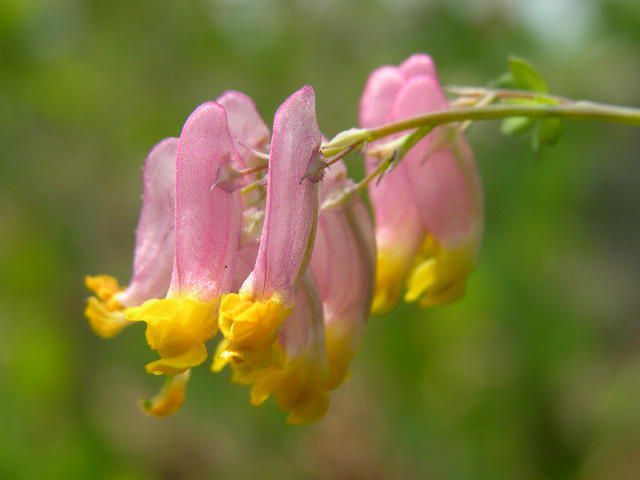

Corydalis flower and varieties of this plant are excellent melliferous plants, in spurs of which a lot of sweet nectar accumulates. True, only insects with long proboscis, such as bumblebees, can get it. The ripe fruit of the plant is a dry pod-shaped box in which seeds are formed. They are large enough, black, with a shiny surface and a juicy white bush - a real delicacy for forest ants, which collect seeds and play an important role in the distribution of the species.
So what is so interesting about the Corydalis? We will consider the description, useful properties, application of this perennial plant further.
Procurement rules
Corydalis tubers are often harvested for medicinal purposes, since the most alkaloids are found in them. The collection of raw materials begins after the plant enters the fruiting phase. This period falls in June.
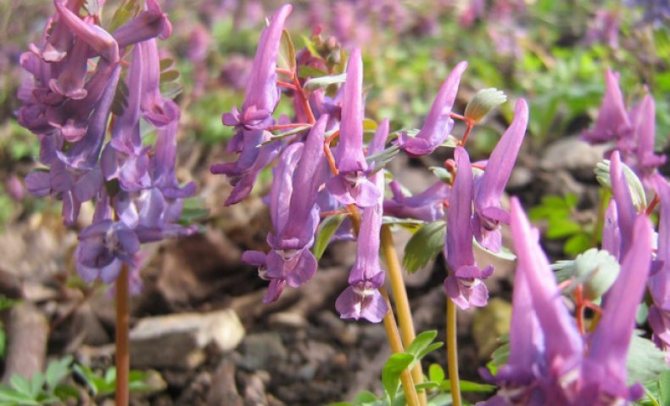

The roots are dug up, shaken off the soil, washed and cut into small slices for drying. Then the blank is laid out on a sheet of cardboard or a fabric flap and left for several days. Corydalis should be dried in a well-ventilated area, away from direct sunlight. Many housewives use attics to procure medicinal herbs.
In the case of the corydalis, first of all, weigh its medicinal properties and side effects, carefully study the contraindications, do not forget to consult a doctor. After all, the grass does not forgive mistakes.
Helpful information
- Gardeners respect the Corydalis for its early flowers, abundance of shades and absolute ease of care. There are about 300 species of this plant in total. Some varieties form bushes, while others gradually grow into a solid flowering carpet. They are planted like flowers on curbs, alpine hills, the most unfavorable and inconvenient slopes. Often used for landscaping gardens and park beds.
- The dried roots are used as a remedy for rodents.
- The plant is considered an abundant honey plant.
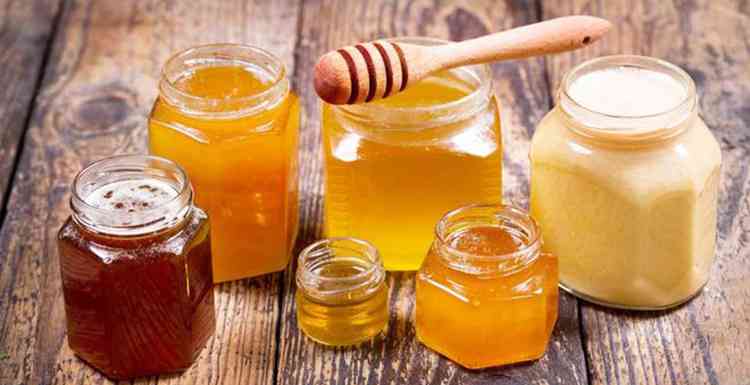

An excerpt characterizing the Corydalis noble
- Oh, you just spoil everything for me. Well, go, go. Again everything fell silent, but Prince Andrey knew that she was still sitting here, he sometimes heard a quiet stirring, sometimes sighs. - Oh my god! Oh my God! what is it! She cried suddenly. - Sleep like that! - and slammed the window."And I don't care about my existence!" thought Prince Andrew as he listened to her talk, for some reason expecting and fearing that she would say something about him. - “And again she! And how on purpose! " he thought. Such an unexpected confusion of young thoughts and hopes, which contradicted his whole life, suddenly arose in his soul that, feeling himself unable to understand his condition, he immediately fell asleep. The next day, having said goodbye to only one count, without waiting for the ladies to leave, Prince Andrei went home. It was already the beginning of June when Prince Andrew, returning home, drove again into that birch grove in which this old, gnarled oak so strangely and memorably struck him. The little bells were ringing even more muffled in the forest than a month and a half ago; everything was full, shady and thick; and the young spruces, scattered in the forest, did not violate the general beauty and, imitating the general character, gently greened with fluffy young shoots. The whole day was hot, where a thunderstorm was gathering, but only a small cloud splashed on the dust of the road and on the juicy leaves. The left side of the forest was dark, in shadow; the right one, wet, glossy, glittered in the sun, slightly swaying from the wind. Everything was in bloom; nightingales crackled and rolled now near, now far. “Yes, here, in this forest, there was this oak tree with which we agreed,” thought Prince Andrey. "But where is he," thought again Prince Andrew, looking at the left side of the road and without knowing it, not recognizing him, admired the oak for which he was looking. The old oak tree, all transformed, stretched out like a tent of luscious, dark greenery, melted, swaying slightly in the rays of the evening sun. No gnarled fingers, no sores, no old mistrust and grief - nothing was visible. Juicy, young leaves made their way through the tough, century-old bark without knots, so that it was impossible to believe that this old man had produced them. “Yes, this is the same oak tree,” thought Prince Andrey, and suddenly an unreasonable, springtime feeling of joy and renewal came over him. All the best moments of his life were suddenly recalled to him at the same time. And Austerlitz with the high sky, and the dead, reproachful face of his wife, and Pierre on the ferry, and the girl, agitated by the beauty of the night, and this night, and the moon - and all this suddenly recalled him.
Corydalis application
1. In case of Parkinson's disease, paralysis, tremors, pain in muscles and joints, you need to use such a recipe, for it you need to take a teaspoon of the tuber, be sure to chop it thoroughly, and boil it in a glass of boiling water. Drink up to 3 times one tablespoon.
2. If sleep is disturbed, nervousness is increased, you need to use such a recipe, grind the crested into powder, take it before bedtime.
3. In case of gynecological diseases, if the menstrual cycle is disturbed, colitis is disturbed, it is necessary to prepare an infusion with corydalis tubers, it will require twelve teaspoons of chopped grass, half a liter of boiled water, insist up to one hour.
4. In the morning and in the evening, up to 12 corydalis tubers should be taken if you are worried about pyoderma and furunculosis.
5. If the pain does not stop for a long time after childbirth, heaviness arises in the head, the body temperature rises, the person is very weak, you need to use a powder based on corydalis in a crushed or fried form.
6. Corydalis is a part of the pharmaceutical preparation "Sanguirithrin", it is used for myopathy, if the muscular system is sluggish, if it is sensitively disturbed in the motor system. Most often, an ointment is used, it is applied in a small amount to the affected area. The skin can be very hot if it is inflamed. Therefore, it is imperative to cancel this ointment. It is used with caution in patients with epilepsy, bronchial asthma, angina pectoris.
When and how it blooms
Types of flowers
Narcissus flower: yellow, white, pink, tubular species
Corydalis flowers always grow in lush inflorescences, they can be more or less elongated downward. The sweet nectar that accumulates in the spurs attracts bumblebees. Corydalis flowers differ in color: they can be yellow and white, pink and lilac, blue and purple.
Flower shapes
More often found in inflorescences, but there may be single flowers. Flowers are honey plants, each has a spur in the upper part, in which insects find nectar. Fading away, the plant forms a box with seeds.
Flowering period
In natural conditions, it blooms in early spring, in a garden, the plant can bloom from May to September, although some garden species bloom in late April.
Crested Crested Care in the Garden
When growing a corydalis in a garden, it should be watered, weeded, fed, loosened the soil surface and protected from pests and diseases in a timely manner. But it should be borne in mind that different types of care requirements and preferences may differ.
How to feed and water
In the first weeks of spring, when the corydalis begins to grow, as a rule, the soil is rather moist from melt water, so the plants will not need to be watered. After the earth dries out, the plants will need to be watered systematically. It should be borne in mind that alpine and desert species should be provided with moderate watering, since they react negatively to stagnant moisture in the root system, while a short drought causes much less damage to the plant. It must be remembered that any of the corydalis species reacts extremely negatively to stagnant water in the ground, in this regard, the land on the site must be well-drained. When the bushes are watered, you need to loosen the surface of the site, while removing the weeds. To reduce the number of weeding, watering and loosening, the surface of the site must be covered with a layer of organic mulch.
How to collect, dry, store
For medicinal raw materials, tubers, rhizomes and the ground part are harvested during the budding period, when the concentration of alkaloids in the grass and flowers is maximum. rules blanks:
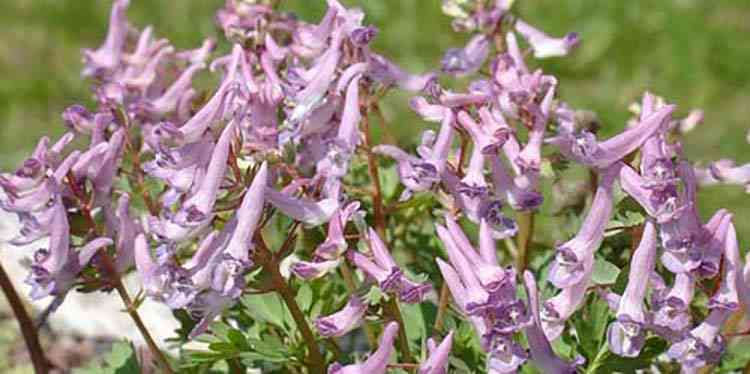

- The roots and tubers are dug up in September-October, washed, cut into thin slices and dried with constant turning. The dried slices are crushed to the state of flour, poured into a dark sealed container and removed away from children and pets.
- The ground part is cut off with scissors or a sickle so that the juice does not get on the skin of the hands, on the mucous membrane of the mouth and eyes. The grass is slightly crushed and dried in a ventilated area.
- You can not stay in the room for a long time where raw materials are dried. When turning over, wear a mask to protect the mucous membranes of the mouth and nose from small flying dust particles. Intoxication during harvesting is manifested by headache, nausea, partial loss of vision.
- Raw materials are stored for a year.
Share in the comments if you have ever used Corydalis-based drugs for treatment.
Possible growing problems
In nature, the plant lives simply and without any conditions, this property is preserved on the territory of the garden. Corydalis pests, despite its unpretentiousness, are still susceptible. Among diseases, fungi and viruses are dangerous, foliage and stems suffer from them. Having found an infection on the flower bed, the diseased parts must be removed and burned.
Important! The main enemies of the crested are mice and moles, they gnaw the tubers, which leads to decay.
What forest can do without primroses! It is a pity that they are not yet very common in cultural gardening. The photo below shows how beautiful a crested bird can look when transferred to the garden. So far, she appears more in scientific reports on primroses, but, who knows, maybe soon it will become part of guides about the most popular varieties of garden flower crops.

